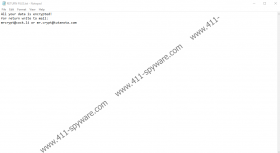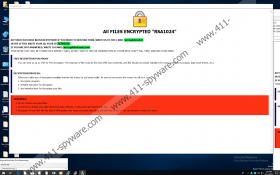MGS Ransomware Removal Guide
MGS Ransomware is one of those threats that can encrypt your personal files and make it impossible for you to restore them using legitimate decryptors. Unfortunately, it is just one of the thousands of infections alike, and if you do not encounter it, there are plenty of others that could take its place. Because file-encrypting ransomware is so prevalent these days, most Windows users already know that their systems need to be safeguarded at all times and that their personal files need to be backed up outside their computers. If you need to delete MGS Ransomware, it is unlikely that your operating system is protected reliably, but, hopefully, backups exist. If they do, you can remove the corrupted files and replace them with backups. Of course, whether or not you can salvage your precious photos and important documents, you still need to eliminate the malicious threat, and the tips and guides we share in this article should make the process much easier.
It took no time at all for our research team to figure out that MGS Ransomware comes from the Crysis (or Dharma) Ransomware family. That is because Wal Ransomware, Zatrov Ransomware, Masodas Ransomware, and all other threats from the same family have already been analyzed in our internal lab and reported on this website. Although every single one of these infections is identified as a unique threat, they are pretty much identical. For one, they usually exploit spam emails, unreliable downloads, and vulnerable remote desktop connections to enter operating systems. After execution, they all encrypt files silently and then launch windows with email addresses presented as their titles. In the case of MGS Ransomware, the title of the window is “mrcrypt@cock.li,” and it is also the email address that can connect the victims to their attackers. According to the note delivered via the window, the victims must email mrcrypt@cock.li or mr.crypt@tutanota.com to get information that would make it possible to pay a ransom in return for a decryptor.
A file named “RETURN FILES.txt” reaffirms the request for you to contact the attackers, and you are likely to find this file in the local drive, or copies could be created everywhere. If you decide to send a message, you need to be smart. First and foremost, do not use your email account, or the attackers behind MGS Ransomware could flood your inbox with new spam email messages. Note that those could be very misleading and you might end up interacting with them by accident. Second, remember not to open links or files sent by the attackers mindlessly because that could lead to the infiltration of new infections. In general, we do not recommend interacting with cybercriminals because that is dangerous. Of course, if you cannot replace the encrypted files (the ones with the “.id-{unique ID}.[mrcrypt@cock.li].MGS” extension) with backups, you might think you are out of options. Unfortunately, the MGS Ransomware decryptor that the cybercriminals are dangling in from of your nose is unlikely to be given to you anyway.
Are you ready to locate and remove MGS Ransomware components manually? You need to find and delete all .exe files, ransom note files, as well as registry entries created by this infection. Not all victims will be ready to erase this threat manually, but that is a problem that has a very simple solution – legitimate anti-malware software. If you install it now, all active infections will be removed automatically, and you will not need to do more than launch the program, initiate a scan, and click a button to initiate the removal of the detected threats. The right anti-malware program will also reinstate the complete security of your system, which is what you need if you want to evade new threats in the future. Unfortunately, this program will not restore your files, and it is unlikely that a program capable of that exists at all. We certainly would not rely on the tool offered by the attackers.
How to delete MGS Ransomware
- Right-click and Delete the ransom note file named RETURN FILES.txt.
- Launch Windows Explorer by tapping Win and E keys at the same time.
- Navigate to these folders (enter into quick access) and Delete malicious Info.hta and {random}.exefiles:
- %APPDATA%
- %APPDATA%\Microsoft\Windows\Start Menu\Programs\Startup\
- %ALLUSERSPROFILE%\Microsoft\Windows\Start Menu\Programs\Startup\
- %ALLUSERSPROFILE%\Application Data\Microsoft\Windows\Start Menu\Programs\Startup\
- %WINDIR%\System32\
- Launch Run by tapping Win and R keys at once and then enter regedit into the open box.
- In Registry Editor, go to HKEY_LOCAL_MACHINE\SOFTWARE\Microsoft\Windows\CurrentVersion\Run.
- Right-click and Delete three unique values linked to Info.hta and {random}.exe files.
- Exit all utilities and then Empty Recycle Bin.
- Install a reliable malware scanner and use a system scan to check for potential malware leftovers.
MGS Ransomware Screenshots:



